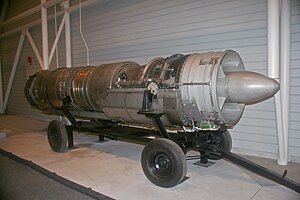Orenda Iroquois
| PS.13 Iroquois | |
|---|---|
 |
|
| Orenda Iroquois at the Canada Aviation Museum in Ottawa. | |
| Type | Turbojet |
| National origin | Canada |
| Manufacturer | Orenda Engines |
| First run | 15 December 1954 |
| Major applications | Avro Canada CF-105 Arrow |
| Developed from | Avro Canada Chinook |
The Orenda PS.13 Iroquois was an advanced turbojet engine designed for military use. It was developed by the Canadian aircraft engine manufacturer Orenda Engines, a part of the Avro Canada group. Intended for the CF-105 Arrow interceptor, development was cancelled, along with the Arrow, in 1959.
For the CF-105 Arrow project, Avro Canada had originally intended to use one of three different engines, all UK designs: Rolls-Royce RB.106, the Bristol B.0L.4 Olympus, or a license-built version of the Olympus, the Curtiss-Wright J67. The RB.106 and J67 were selected as the primary and backup engines for the new design. However, both the RB.106 and J67 were cancelled during the Arrow's design phase, too far into the program to select the Olympus. Orenda Engines quickly responded with the PS.13 Iroquois design.
In overall design terms, the PS.13 was similar to the RB.106, using a "two-spool" layout with low-pressure and high-pressure sections of the compressor for added efficiency. It differed slightly in being somewhat more powerful, especially in afterburner. However, the design also incorporated a number of new design features intended to improve simplicity and lightness. With this in mind, Orenda pioneered work in the use of titanium in engines, with 20% by weight of the Iroquois (mainly the compressor rotor blades) consisting of this metal. Titanium has light weight, high strength and good temperature and corrosion resistance. It was estimated that the engine would be 850 pounds (386 kg) lighter than if steel had been used. During the early 1950s, this material was in short supply, and the lack of knowledge of its physical properties and fabrication techniques created problems which had to be overcome. It was also very expensive relative to the more common materials such as steel and aluminum.
It was recognized that if the engine parts could be designed with titanium, then the supporting structure could also be lightened due to reduced forces within the engine, with an overall saving in weight. Other parts, such as gearbox casings were made with a magnesium alloy. Inconel was used to make the blades in the low pressure turbine assembly and the metal insulation blanket found at the rear of the engine. This heat resistant nickel-chrome alloy retains its strength at high temperatures and resists oxidation and corrosion. The primary reason for using these advanced metals was to save weight and improve performance, creating an engine with a 5:1 thrust to weight ratio that could produce a sea level dry thrust of 19,250 lb (26,000 lb with afterburner). The design, development and manufacture of such an advanced jet engine was accomplished in an incredibly short time by the Orenda team. The detailed design was completed in May 1954, and the first run was achieved in December 1954. The earlier Orenda 9 had more parts but produced less power. For example, the Orenda 9 weighed 2,560 lb (1,160 kg) and produced 6,355 lb (2,883 kg) static thrust, while the Iroquois weighed 5,900 lb. (2,675 kg) but was reported to have produced 30,000 lb (13,608 kg) static thrust with afterburner for takeoff. (The Orenda did not have an afterburner.)
...
Wikipedia
